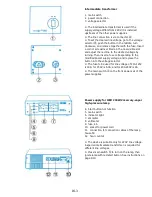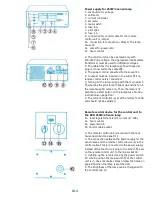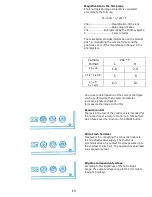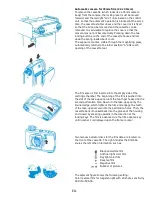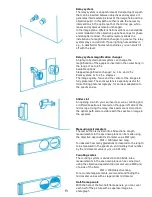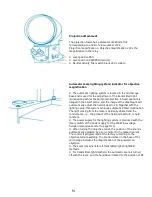
F1
Ocular body
The Interpupillary distance is set with the knurled control knob
➂
, and can be
read on the scale
➀
in millimeters.
Before focusing on the specimen image, the eyepieces must be adjusted to
the correct height, taking into account the different visual acuity of the two
eyes. This is done by first using the relay. A micrometer scale slider, or the
camera format-limit slider, is placed into the relay slot. The image is then
focused sharply for each eye by twisting the eyepiece eye lenses individually.
If not using the relay, a specimen on the stage is first focused with one eye,
using coarse and fine focus controls, and then adjust the focus for the second
eye, used by itself, by twisting the other eyepiece. When then using both
eyes, the image should be in mutual focus.
In the tube, a neutral density filter is installed. It acts only on the view
through the ocular body and dampens excessive light to the observer, if full
light intensity is being used for projection or photography. To engage the
neutral density filter, use the knurled wheel
➁
. If filter is turned on, the black
dot is visible.
Revolving stage 28
The specimen slide is clamped between a fixed corner and a spring-loaded
hook. The 50 x 75mm coordinate movements operate with the coaxial drive
knurled knobs. The positions of the coordinates can be read accurately to the
millimeter divisions with verniers to 0.1mm. The verniers are located in the
red areas of the divisions. The table can be rotated 180° after loosening the
lever
➃
. Thus, you can fit the specimen to the camera format in photography
and bring interference contrast specimens into the best contrast position.
After loosening the fastening screw of the specimen slide positioner, it can be
removed from the stage table.
Coarse drive stop
The adjustable coarse-focus drive-stop limits the height setting of the stage
table with the coarse feed, and thus facilitates the focus of preparation and
prevents slide breakage.
First, completely lower the stage with the coarse motion control. Then lower
also with the fine motion control until the coarse motion knob starts to rotate
in opposite direction to the fine motion knob. In this basic setting of the
coarse and fine motion, the height of the stage, after releasing the clamping
lever
➆
, can be adjusted on its special guide and the coarse-motion stop can
be set to the specimen thickness. For normal transmitted-light specimens on
slides of 1mm approx. thickness, the stop is set so that the end of the plate
➄
is level with the end of the guide
➅
. IMPORTANT NOTE: The above
described basic setting of the coarse and fine motion should be checked from
time to time, or reset, so that the maximum range of the coarse motion is
preserved.
Condenser: coarse and fine drive
The coarse adjustment is done with the knurled wheel
➇
. The fine
adjustment (range 1mm), that is maintained during the lowering of the
condenser with the coarse (fixed focus setting), is done with the knurled
wheel
➈
.
The stiffness of the coarse feed can be adjusted as follows:
Condenser coarse feed is too easy: turn the coarse feed to the lower stop
position and then continue to rotate the knob a little bit more than the limit
stop.
Condenser coarse feed is too hard: turn the coarse feed to the upper stop
and then turn the knob a little further until the correct tension is set.
The special accessories were already described in the different working methods. In the following, you will find general
instructions that make it easier for you to work with the Univar.
Содержание Univar
Страница 1: ...Reichert Univar Manual...
Страница 2: ......
Страница 48: ...D6 blank no content...
Страница 58: ...E2 blank no content...

